Channels in Microsoft Teams are somewhat similar to conference rooms, where different departments or teams hold client meetings, brainstorms, retrospectives, etc. In Microsoft Teams, channels have a similar function. It’s a space where your team members can hold meetings, chat, share files and work on them together. Channels often reflect a certain topic or a project depending on how you prefer to organize your team. So, this is where the actual magic (aka the work) takes place.
Users refer to Channel Permissions in Microsoft Teams when they wish to better organize collaboration in channels. That applies to what capabilities different types of users get in distinct channels, who can own and get access to channels, who can create posts and reply to channel conversations, and other.
Besides their default features, you can enhance channels with a number of different apps and tabs that make collaboration easier and more efficient.
There are standard, private, and shared channels. Standard channels are open to everyone in the team while private ones have limited membership, and you can determine who can be a member of these channels. How do you do that? How can you manage channel membership in Microsoft Teams? Keep reading to find out.
An overview of channel roles and permissions
In any given team, there are two main roles that determine their permissions:
1. Team owner
This is the person who creates the team. They can invite anyone from their organization to join the team. Besides their employees/colleagues, they can also invite clients or partners as guests, but we will talk about it in detail later. Team owners also have the ability to make any member of their team a co-owner, which is strongly recommended. Having another co-owner significantly decreases the risk of having orphaned teams. You can learn more about what that means here.
2. Team members
These are people who’ve been invited to join a team. Depending on whether the team is public or private, they have distinct capabilities. For example, in a private team their capabilities are much more limited than those of team owners.
3. Guests
These are users outside of your organization that can temporarily join the team with an invite from the team owner. These can be partners, clients, suppliers, consultants, etc. As guests, they will have fewer capabilities and permissions.
Here is a table by Microsoft that sums up the different permissions that each role has:
| Capability | Owner | Member | Guest |
| Create a channel | ✓ | ✓ | ✓ |
| Participate in a private chat | ✓ | ✓ | ✓ |
| Participate in a channel conversation | ✓ | ✓ | ✓ |
| Share a channel file | ✓ | ✓ | ✓ |
| Share a chat file | ✓ | ✓ | |
| Add apps (such as tabs, bots, or connectors) | ✓ | ✓ | |
| Can be invited via any work or school account for Microsoft 365 | ✓ | ||
| Create a team | ✓ | ✓ | |
| Delete or edit posted messages | ✓ | ✓ | ✓ |
| Discover and join public teams | ✓ | ✓ | |
| View org chart | ✓ | ✓ | |
| Add or remove members and guests | ✓ | ||
| Edit or delete a team | ✓ | ||
| Set team permissions for channels, tabs, and connectors | ✓ | ||
| Change the team picture | ✓ | ||
| Add guests to a team | ✓ | ||
| Auto-show channels for the whole team | ✓ | ||
| Control @[team name] mentions | ✓ | ||
| Allow @channel or @[channel name] mentions | ✓ | ||
| Allow usage of emoji, GIFs, and memes | ✓ | ||
| Renew a team | ✓ | ||
| Archive or restore a team | ✓ |
Channel moderation
There is one additional role that team owners can activate – moderator. When activated, by default the moderator of that channel is the team owner. But the team owner can assign that role to other members as well. Moderators are usually department heads or project managers, who have more expertise in the area that the channel covers, so they’ll be better at managing it. Moderators have the following permissions:
- Start new posts in the channel. When moderation is turned on for a channel, only moderators can start new posts in that channel.
- Add and remove team members as moderators to a channel. Keep in mind that by default, team owners are channel moderators and can’t be removed.
- Control whether team members can reply to existing channel messages and whether bots and connectors can submit channel messages.
To activate channel moderation, click on the three dots next to the channel then Manage Channel. Make sure you choose On and then click Manage to add new moderators.
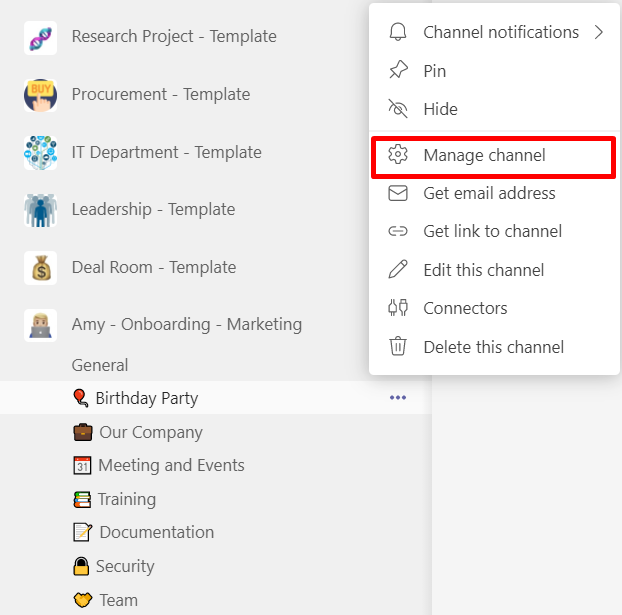
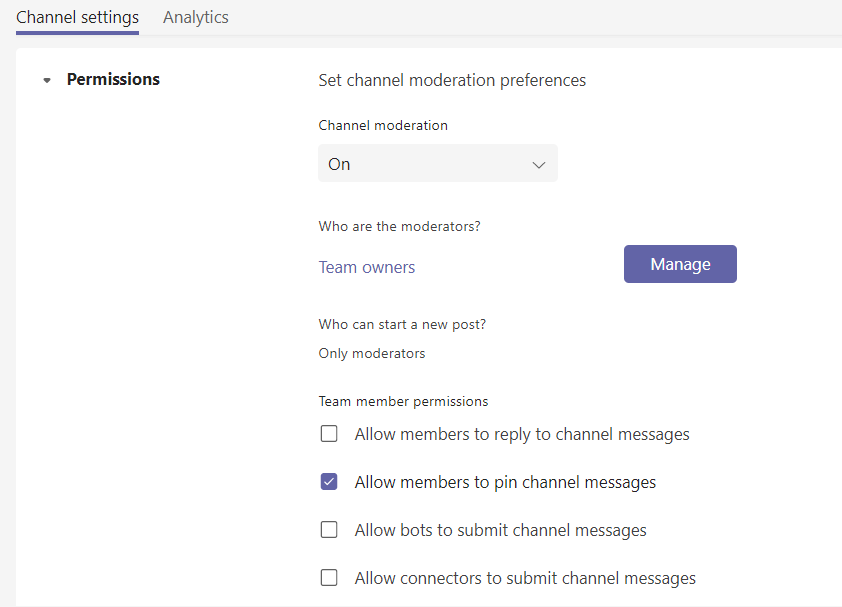
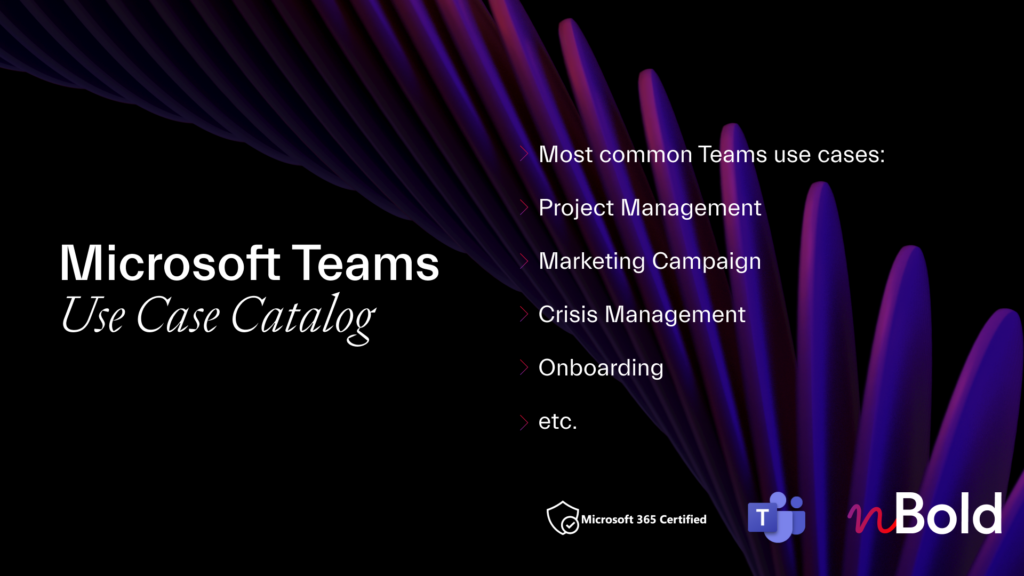
Catalog of Microsoft Teams Use Cases
Discover the most common Microsoft Teams scenarios and use cases! Project Management, Marketing Campaigns, Sales Deal Room, and much more.
Private vs. standard channels and what that means in terms of channel permissions
As already briefly noted, channels can be standard and private. In short, standard channels are accessible by all members of that specific team. On the other hand, private channels have restricted access and only channel owners and certain members can enter it. Private channels can be created in any team and as an owner, you can assign access to only those members, who can be part of that limited communication.
Private channels also have three main roles – private channel owner and channel members that may include guest users. By default, both team owners and team members can create a private channel, but this capability can be deactivated from the admin center by the team owner.
Channel permissions in Microsoft Teams granted to owners, members and guests in private and standard channels are alike. However, being a member of a private channel, in and of itself, is “a special permission.” Private channel members have access to information and communication that the rest of the members don’t. So, when you’re configuring channel permissions, keep in mind that creating a private channel can be considered a permission too.
In regard to the permission settings within private channels, owners can allow members to:
- Create, update, and remove tabs.
- Delete their messages.
- Edit their messages.
- Mention @channels.
All capabilities are activated by default, so if you want to change them, you need to do it manually.
Learn more about private channels here.
How to manage channel permissions in Microsoft Teams?
Managing channel permissions in Microsoft Teams is a fairly easy and straightforward process. To find the permission settings, click on the three dots next to the channel name, select Manage Channel and it will direct you to the following page. As you can see, you have very limited choices in terms of assigning or removing any permissions. If you select On for Channel moderation, you’ll be presented with more choices.
How to set up guest permissions
To add a guest to your channels, you need to add them to the team firs. To do so, click on the three dots next to your team’s name, select Add member. Type the email address of the guest that you want to add and Microsoft Teams will give you the option to either add that user as a member or as a guest – select as a guest. Keep in mind that when you add guests to any team, they by default have access to all channels except for the private ones. You can add your guests to your private channels and when they’re no longer needed in your team, remove them from it altogether.
To manage the permissions of the guest, once again click on the three dots next to the team’s name and select Manage team. From there go to Settings and choose Guest permissions.
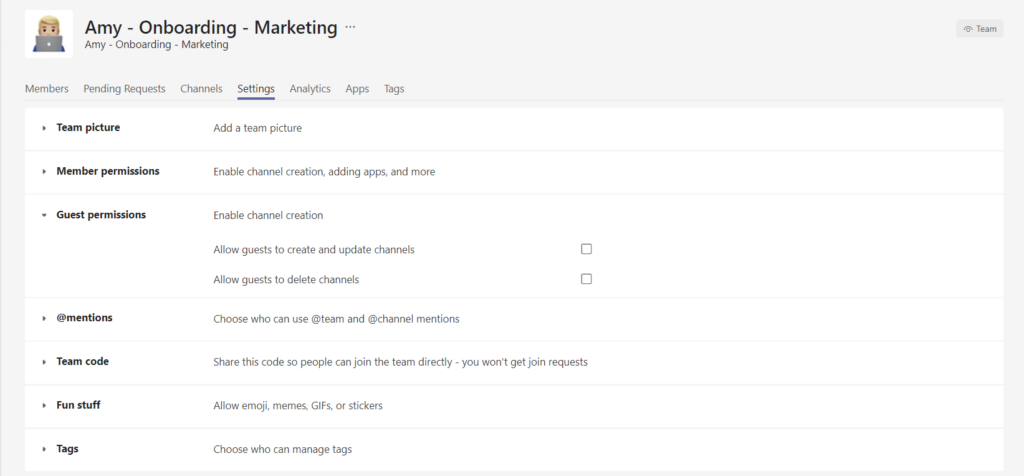
Currently, you can enable guests to:
- Create and update channels, and
- Delete channels
These permissions are deactivated by default, so you can leave them as they are or enable them.
To reduce manual work, you can use native or third-party template solutions like nBold. You will need to create one team on which you will base your template and configure the channel permissions and when you use the template to create the rest of the teams, the configurations will automatically apply.
Enforcing private channel security with Collaboration Templates
To make sure you have better control over private channel management of your teams, you may want to create Microsoft Teams Collaboration templates where you build standard and private channels that will be replicated to new teams.
This will allow you to have private channels in your teams, which can be an absolute must in certain scenarios when you need to collaborate on sensitive data with specific people from your team. At the same time, you can control what information is being shared in these channels and who becomes private channel members.
With Collaboration templates, you pre-build channels and add private channel members at the template level. This means that these people will be automatically added to the private channels you’ve built whenever a new team in created from the template.
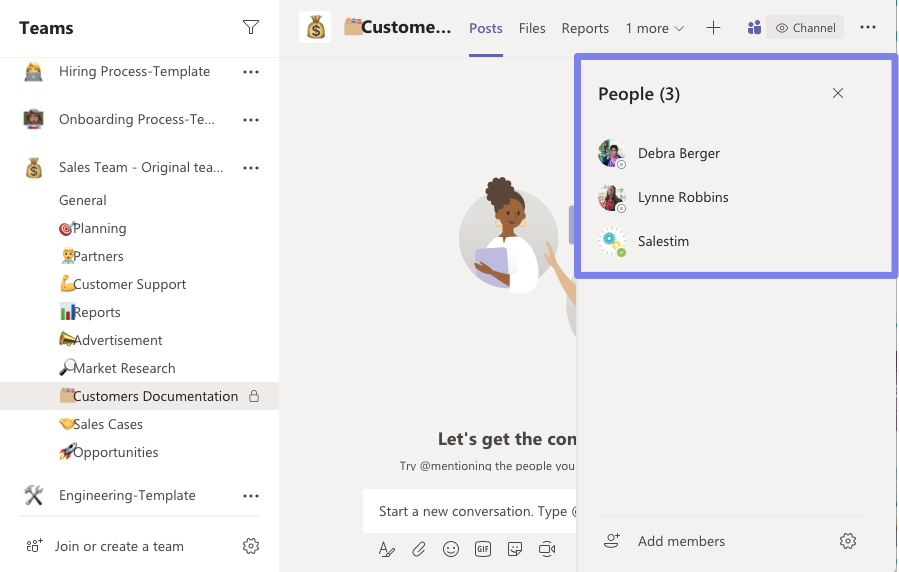
You can learn more about Collaboration Templates here.
The key to channel permissions in Microsoft Teams is to closely pay attention to the default settings and then modify them based on your needs. It is important to find a middle ground between what the members and guests can and can’t do. Give members and guests permissions that enable effective collaboration but don’t pose security risks.
